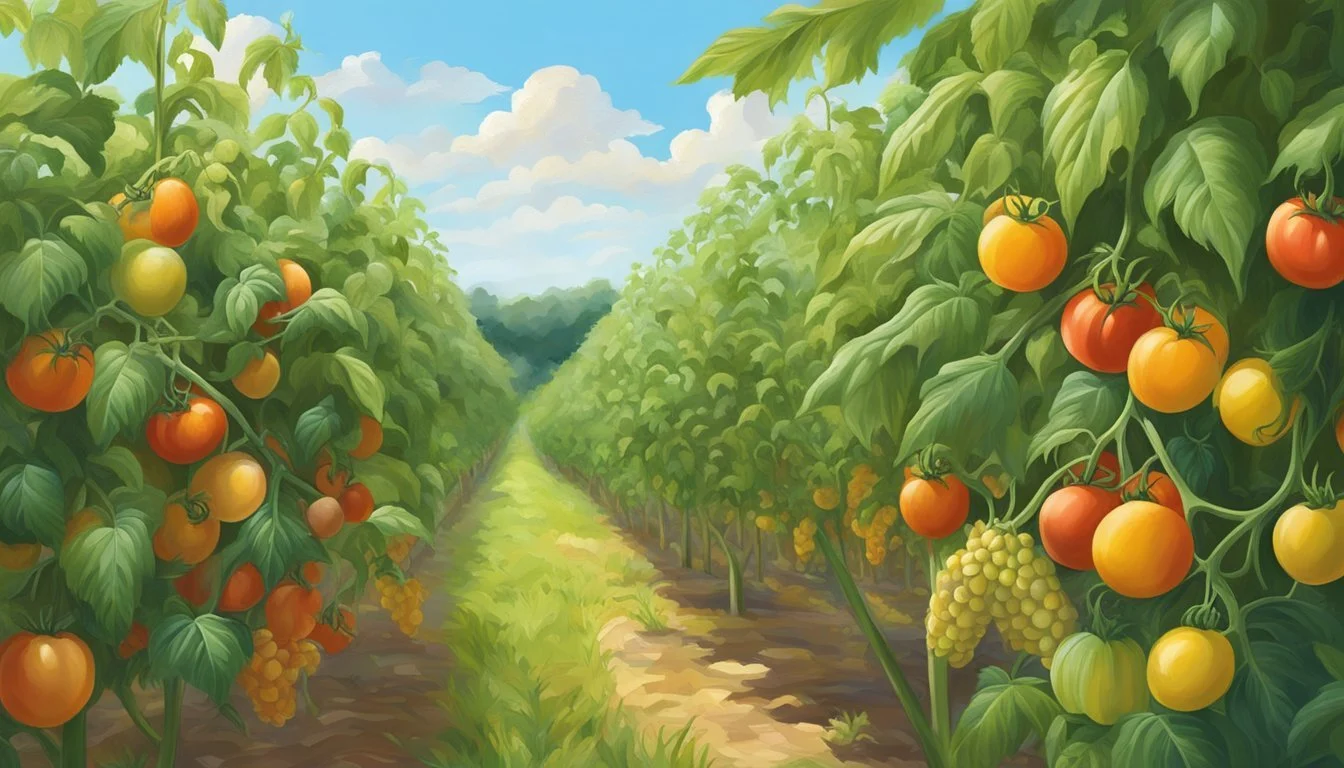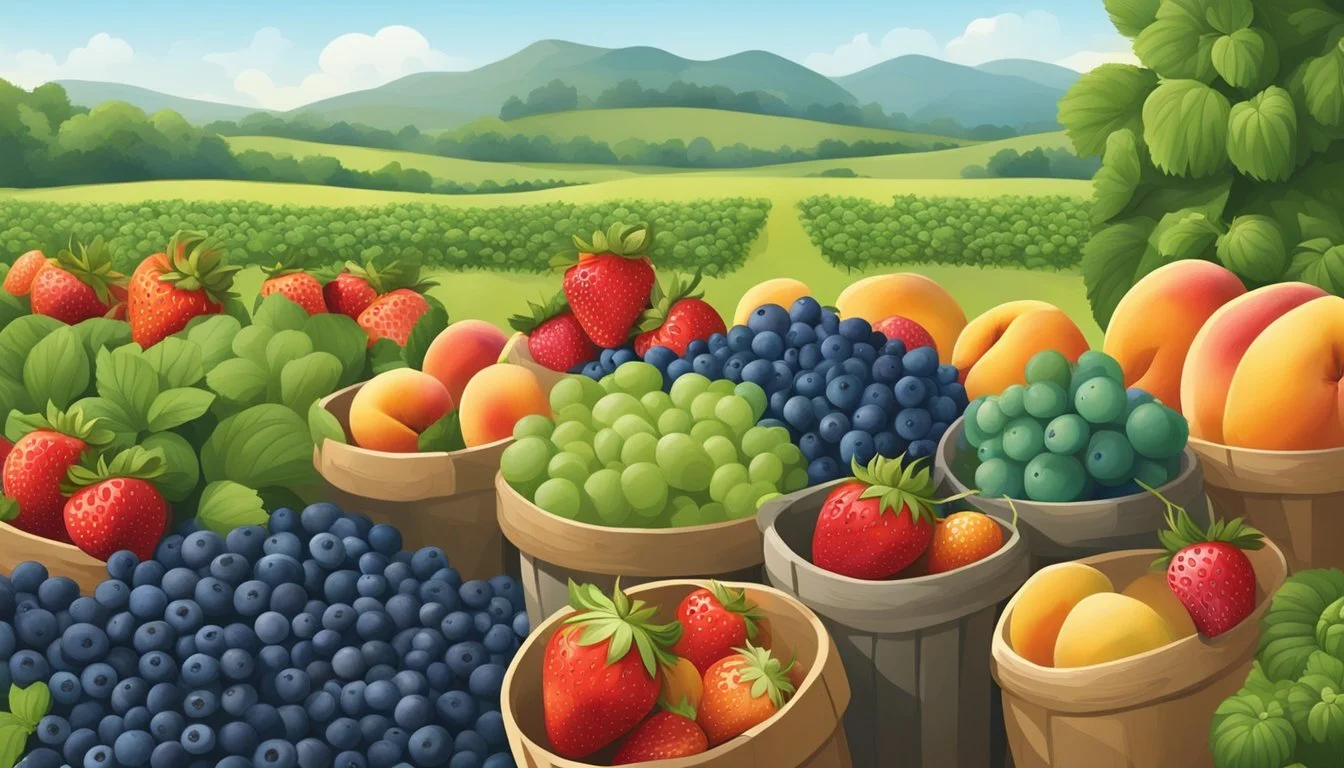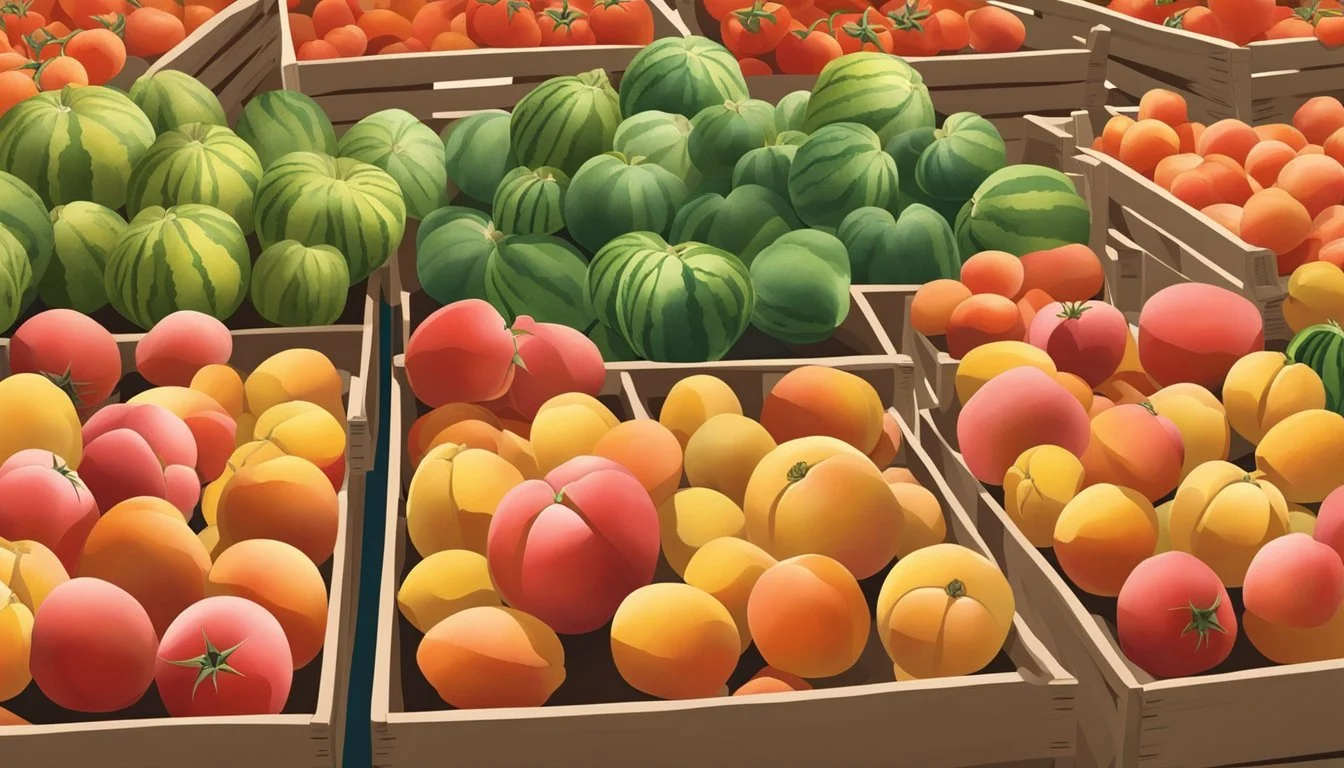North Carolina Seasonal Fruit & Vegetables in July
Your Fresh Guide
This Article is Part of our North Carolina Seasonal Fruit & Veg Calendar
North Carolina's warm climate and rich soil contribute to a diverse agricultural landscape, yielding a variety of fresh produce throughout the year. July, in particular, marks a bountiful period where summer's heat brings an abundance of fruits and vegetables to their peak ripeness. The sensory delights of this month are unmistakable — from the vibrant hues of fresh produce at local farmers' markets to the unmistakable aroma of ripe peaches in the air.
In July, residents and visitors alike enjoy a selection of fruits and vegetables that are not only fresh but are also at their nutritional zenith. Among the fruit, the succulent peach is a star of North Carolina's summer, perfectly in season and bursting with flavor from June through September. Berry lovers can revel in the last of the blueberries (how long do blueberries last?), a sweet summer staple available through July. Watermelon, synonymous with summer refreshment, is also ready to be sliced and enjoyed during this month.
For those seeking out fresh vegetables, July does not disappoint. Okra, a southern cuisine favorite, enters its prime mid-month, offering its distinct texture and flavor to a variety of dishes. Cucumbers (how long do cucumbers last?) and butter beans are also plentiful, providing crispness and comfort to any summer plate. With these seasonal offerings, North Carolina's July harvest allows for nutritious, flavorful meals that capture the essence of summer.
Seasonal Fruits Overview
July in North Carolina is a vibrant time for fruit lovers, offering a variety of ripe, flavorful, and fresh fruits. Many fruits reach their peak in summer, providing an abundance of options that are perfect for eating fresh or using in summer recipes.
Stone Fruits
Peaches: In July, peaches are at their juicy best in North Carolina. These stone fruits are known for their soft, fuzzy skin and sweet flesh, making them a favorite for both eating raw and in desserts.
Berries
Blueberries: These small but mighty fruits are a summertime treat. Fresh North Carolina blueberries are in season in July, bursting with flavor and perfect for eating by the handful or in pies and salads.
Melons
Watermelon: Synonymous with summer, watermelons in North Carolina are incredibly refreshing in July. With their crisp texture and sweet, hydrating juice, watermelons are a popular choice for picnics and barbecues.
Seasonal Vegetables Overview
July in North Carolina is a time when an array of vegetables are reaching their peak of freshness. Consumers have the opportunity to enjoy produce that is not only richer in flavor but also more nutritious due to the reduced time between harvest and consumption. Here is an overview of the vegetables that are prime for the picking during this month.
Leafy Greens
Kale, a nutrient-packed leafy green, thrives in the state's summer climate, making it a fresh and abundant choice. Shoppers may find various types of kale, ranging from curly to flat-leaf, all boasting deep colors that signal their freshness and nutritional density.
Root Vegetables
Carrots are a versatile root vegetable that maintains its sweet flavor and satisfying crunch when harvested in July. They are available year-round, but the summer months provide an ideal condition for them to develop a heightened sweetness, embodying the season's essence.
Summer Staples
Tomatoes: These juicy fruits, often grouped with vegetables in culinary contexts, hit their stride in July. Look for a variety of shapes, sizes, and colors in the local markets.
Corn: Corn is synonymous with summer, and in North Carolina, July marks a time for some of the freshest and sweetest cobs.
Cucumber: Perfect for adding a cool crunch to salads, cucumbers are plentiful during this warm month.
Each of these vegetables can be found fresh in the state, ensuring that meals are both delightful and seasonally appropriate.
Farm-To-Table Experience
July in North Carolina is the pinnacle of summer's bounty, with a variety of fresh, local produce coming straight from the farm to the dining table. This transition not only supports the local economy but ensures that people enjoy the freshest and most nutritious fruits and vegetables of the season.
Farmers Markets
Farmers markets across North Carolina become vibrant hubs in July, showcasing an array of summer produce. Shoppers can expect to find:
Peaches: Juicy and ripe, perfect for summertime desserts or fresh eating
Blueberries: A local favorite, available for salads, baking, or snacking
Cucumbers and Watermelons: Refreshing in the summer heat
Tomatoes: A variety of heirlooms, cherry, and slicing tomatoes
Corn: Sweet corn is a staple at many market stands
At farmers markets, the interaction between farmers and consumers allows for a deeper understanding of where food comes from and the importance of sustaining local agriculture.
Community Supported Agriculture
Community Supported Agriculture (CSA) programs in July offer a direct line from the farm fields to local tables. Participants in CSAs receive:
Regular shares of the farm's produce, reflecting the seasonal availability
Opportunities to form relationships with the farmers who grow their food
It's a symbiotic relationship where local farms receive upfront support for their seasonal operating costs and community members enjoy the freshest summer produce, often picked the same day they receive it.
Gardening Tips for July
In North Carolina's warmer climate, July marks an important month for gardeners to manage both vegetables and fruits effectively. For a fruitful harvest, gardeners in the state should consider the following advice.
Watering: It is critical to water gardens deeply and infrequently to establish stronger and more resilient roots. This method proves more effective than shallow, frequent watering, especially during North Carolina’s summer months.
Harvesting: Regular harvesting prevents plants from ceasing flower and fruit production. Certain crops such as okra, string beans, garden peas, cucumbers, summer squash, and tomatoes benefit from daily picking, which can increase yield.
Planting Vegetables: For those looking to add to their garden in July, radishes are a viable option due to their fast growth rate and preference for cooler fall temperatures. It's also a suitable month to plant beans, carrots, brussels sprouts, and begin to start broccoli, cabbage, and cauliflower in peat pots for transplantation in mid-August.
Planting Fruits: Fruit gardening endeavors can focus on maintenance rather than planting new fruit-bearing plants, as July is not the prime planting season for most fruits in North Carolina.
Soil Care: They must ensure that the soil is well-drained, adding compost if necessary to improve its structure and fertility.
Zone Understanding: Gardeners should consider North Carolina’s Zone 7 requirements, which dictate the ideal planting times and plant hardiness acceptable for the region.
By following these tips, North Carolina gardeners can optimize their July gardening practices for a successful summer and fall harvest.
Health Benefits
Eating fresh fruits and vegetables in their peak season, such as those available in North Carolina during July, offers numerous health benefits. Seasonal produce tends to be fresher, which can enhance its nutritional value.
Fruits like blueberries and cantaloupes(how long does cantaloupe last?) , which are in season in North Carolina during July, are especially beneficial. Blueberries are renowned for their antioxidant properties, aiding in the prevention of oxidative stress. Cantaloupes, rich in vitamin A and C, support immune function and skin health.
Vegetables, including cucumbers and okra, also abound in this month. Cucumbers are hydrating and contain vitamin K, essential for bone health, while okra is a good source of fiber, which aids digestion, and vitamin C, which has anti-inflammatory properties.
Here is a rundown of the benefits:
Blueberries: Antioxidants, support brain health
Cantaloupes: Vitamin A for vision, Vitamin C for immunity
Cucumbers: Hydration, Vitamin K for bones
Okra: Fiber for digestion, Vitamin C for anti-inflammatory effects
Consuming these nutritious fruits and vegetables raw can maximize their health benefits since cooking can degrade some nutrients. Meanwhile, the health aspect of eating fresh, in-season produce extends beyond the individual. It also supports the local economy and reduces the carbon footprint associated with long-distance food transport.
Lastly, individuals should remember that a diet rich in fruits and vegetables is correlated with a reduced risk of many chronic diseases, including heart disease and some cancers, making the inclusion of July's seasonal produce from North Carolina a healthy choice.
Culinary Ideas
In the peak of summer, the abundance of fresh fruits and vegetables in North Carolina presents numerous possibilities for vibrant culinary creations. From the juicy sweetness of stone fruits in fresh salads to the smoky char of grilled vegetables, (What wine goes well with grilled vegetables?) July's produce invites a celebration of flavors and textures.
Summer Salads
Fresh, crisp salads are ideal for North Carolina's July heat, incorporating a burst of color and flavor with locally sourced ingredients. Bold arugula or basil (how long does basil last?) add peppery or aromatic notes, respectively, to a Summer Greens Salad. Consider tossing in some sliced cucumbers and heirloom tomatoes, garnished with parsley and cilantro for added zest.
Ingredients:
Arugula
Basil
Heirloom tomatoes
Cucumbers
Fresh herbs (how long do fresh herbs last?) (parsley and cilantro)
Grilling
Grilled vegetables take on a deliciously smoky flavor that pairs well with the season's outdoor meals. Vegetables such as okra, which are at their prime in July, can be grilled quickly for a charred, yet crunchy, side dish. To enhance the flavor, one can marinate them in olive oil, garlic, and fresh herbs like cilantro before grilling.
Grilling Ideas:
Garlic and Herb Marinated Okra
Charred Peaches with Basil
Desserts
July's bounty of fruits lends itself to an array of sweet confections. For a refreshing end to a summer meal, one might whip up a simple Stone Fruit Crisp, making use of the ripe peaches and plums. Pairing them with a scoop of vanilla ice cream allows their fresh flavors to truly shine.
Dessert Components:
Crisp Topping: Rolled oats (how long do rolled oats last?), brown sugar, a pinch of cinnamon
Fruit Filling: Peaches, plums, a hint of lemon juice
Through these culinary explorations, North Carolina's seasonal produce can be transformed into delightful dishes that showcase the best of what July has to offer.
Preserving the Harvest
In July, North Carolina’s bounteous produce offers an opportunity for preservationists to secure the summer's flavors for later enjoyment. Preserving fruits and vegetables can be achieved through various methods, including canning, freezing, and drying. Each method has its own strengths and is suitable for different types of produce.
Canning is ideal for many of North Carolina’s July harvests such as peaches and blueberries. The high-acid content in these fruits makes them perfect candidates for water bath canning, which can be done at home with the proper equipment. Vegetables like summer squash can be pickled, a form of canning, to extend their shelf life.
Peaches: Peel, pit, and halve or slice, then can using a water bath method.
Blueberries: Can be canned whole in a light syrup or as jam.
Summer Squash: Slice and pickle for long-term storage.
Freezing preserves the taste of summer with minimal loss of texture and nutritional value. This method works well for most vegetables and fruits, though blanching vegetables before freezing is recommended to maintain quality.
Okra: Blanch and then freeze whole or sliced.
Cucumbers: Slice and freeze for use in smoothies or cold soups.
Drying or dehydrating fruits and vegetables effectively concentrates their flavor and can be accomplished with a food dehydrator or a low-temperature oven.
Cantaloupes: Create melon "leather" or dry as chunks.
Tomatoes: Dry until they are leathery but not brittle for a taste of summer all year.
With these preservation methods, the essence of North Carolina's summer produce can be captured and savored throughout the seasons. Each technique requires attention to detail, proper hygiene practices, and sometimes specific equipment, but the resulting preserved goods are well worth the effort.
Seasonality and Sustainability
In North Carolina, July marks the peak of summer, bringing a bounty of fresh produce that is both in season and sustainable. Consuming local foods within their natural growing season not only supports regional agriculture but also minimizes environmental impact by reducing the need for transportation and storage, which in turn lowers carbon emissions.
Summer Produce in North Carolina
Fruits:
Peaches: Juicy and aromatic, they are at their prime in July.
Watermelons: Sweet and refreshing, perfect for hot summer days.
Blueberries: Plump and rich in antioxidants, readily available.
Muscadine Grapes: Native to the region, they start appearing by late July.
Vegetables:
Cucumbers: Crisp and cool, ideal for salads and pickling.
Okra: Grown locally, often used in Southern cuisine.
Tomatoes: Vine-ripened, bursting with flavor in the summer heat.
Shoppers choosing these local and seasonal products not only enjoy peak flavors but also promote sustainable practices. They help sustain the local economy by supporting North Carolina farmers and reduce demand for out-of-season produce, which is often shipped from distant locations.
Farmers' markets and community-supported agriculture (CSA) programs are great avenues for consumers to access fresh, sustainable crops directly from the source. This direct transaction further reduces the carbon footprint associated with food distribution.
By being mindful of seasonality, consumers can take an active role in creating a more sustainable food system, reaping the benefits of fresh produce while supporting North Carolina's rich agricultural heritage.
Social Media and Seasonal Eating
Social media platforms offer a multitude of resources for consumers looking to engage with seasonal eating habits, specifically in North Carolina during July. They enable not only the sharing of information about what is in season but also provide a community for exchanging recipes, tips, and finding local produce.
Facebook Groups
In July, Facebook groups dedicated to North Carolina produce become hubs for sharing the freshest in-season fruit and vegetable finds. Groups like North Carolina Farm Fresh and North Carolina Seasonal Eaters allow members to post about their latest market hauls, which often include July favorites like peaches and blueberries. Members also exchange tips on preserving these seasonal delights.
Pinterest Boards
Pinterest boards offer a visual feast of what to do with July’s seasonal produce in North Carolina. Curators of boards such as North Carolina Summer Harvest provide pins featuring recipes, canning techniques, and even garden advice. These boards act as a comprehensive guide, inspiring one to utilize fruits like watermelon and vegetables like tomatoes to their fullest potential.
Twitter Accounts to Follow
When it comes to staying updated about the latest in North Carolina’s seasonal produce, several Twitter accounts stand out in July. Accounts like @NCFarmFresh and @EatLocalNC tweet regular updates about which fruits and vegetables are peaking and where to find them. They also retweet recipes and storage tips from food bloggers and local chefs who emphasize the use of fresh, local ingredients.









